Post-Occupancy Evaluation in Post-Disaster Social Housing in a Hot-Humid Climate Zone in Mexico
Abstract
:1. Introduction
1.1. Post-Disaster Social Housing
- Location
- Size of the plot
- Size of the house
- Construction quality
- Strength of the house
- Thermal comfort
- Acoustic comfort
- Functionality
1.2. Housing in Yucatan
1.2.1. Vernacular Houses
1.2.2. Colonial Houses
1.2.3. Modern Houses
2. Materials and Methods
2.1. Thermal Comfort
2.2. Case Study
2.2.1. Questionnaire
2.2.2. Observation through Photographic Documentation
2.2.3. Environmental Monitoring
3. Results and Discussion
3.1. Questionnaire
3.2. Observation
3.3. Monitoring
4. Conclusions
Author Contributions
Funding
Institutional Review Board Statement
Informed Consent Statement
Data Availability Statement
Acknowledgments
Conflicts of Interest
Nomenclature
| =Thermal conductivity, W/(m·K) | |
| d | =Thickness of material, m |
| Icl | =Clothing insulation, clo |
| =Temperature, °C | |
| =Temperature for upper acceptability limit, °C | |
| =Temperature for lower acceptability limit, °C | |
| =Prevailing mean outdoor temperature, °C | |
| =Total thermal resistance, m2·K/W | |
| =Thermal transmittance, W/m2·K |
Appendix A


References
- AghaKouchak, A.; Chiang, F.; Huning, L.S.; Love, C.A.; Mallakpour, I.; Mazdiyasni, O.; Moftakhari, H.; Papalexiou, S.M.; Ragno, E.; Sadegh, M. Climate extremes and compound hazards in a warming world. Annu. Rev. Earth Planet. Sci. 2020, 48, 519–548. [Google Scholar] [CrossRef]
- Sarkodie, S.A.; Strezov, V. Economic, social and governance adaptation readiness for mitigation of climate change vulnerability: Evidence from 192 countries. Sci. Total Environ. 2019, 656, 150–164. [Google Scholar] [CrossRef] [PubMed]
- Hallegatte, S.; Rentschler, J.; Walsh, B. Building Back Better: Achieving Resilience through Stronger, Faster, and More Inclusive Post-Disaster Reconstruction; World Bank: Washington, DC, USA, 2018. [Google Scholar]
- Colglazier, W. Sustainable development agenda: 2030. Science 2015, 349, 1048–1050. [Google Scholar] [CrossRef] [PubMed]
- Pearson, L.; Pelling, M. The UN Sendai framework for disaster risk reduction 2015–2030: Negotiation process and prospects for science and practice. J. Extrem. Events 2015, 2, 1571001. [Google Scholar] [CrossRef]
- UN. Yokohama Strategy and Plan of Action for a Safer WorAld; United Nations: Geneva, Switzerland, 1994. [Google Scholar]
- Protocol, K. Kyoto Protocol. UNFCCC Website. 1997. Available online: http://unfccc.int/kyoto_protocol/items/2830.php (accessed on 1 January 2011).
- UN Office for Risk Reduction. Build Back Better. In Recovery, Rehabilitation and Reconstruction; UNISDR: Geneva, Switzerland, 2017. [Google Scholar]
- Fernandez, G.; Ahmed, I. “Build back better” approach to disaster recovery: Research trends since 2006. Prog. Disaster Sci. 2019, 1, 100003. [Google Scholar] [CrossRef]
- Noy, I.; Ferrarini, B.; Park, D. Build Back Better: What Is It, and What Should It Be? Asian Dev. Bank Econ. Work. Pap. Ser. 2019, 2. [Google Scholar] [CrossRef]
- Cardona, O.D. La Necesidad de Repensar de Manera Holística los Conceptos de Vulnerabilidad y Riesgo. In Proceedings of the International Work-Conference on Vulnerability in Disaster Theory and Practice, Wageningen, The Netherlands, 29–30 June 2001. [Google Scholar]
- Jha, A.K.B.; Duyne, J.; Phelps Priscilla, M.; Daniel, P.; Stephen, S. Safer Homes, Stronger Communities: A Handbook for Reconstructing after Natural Disasters; World Bank: Washington, DC, USA, 2010. [Google Scholar]
- Pamidimukkala, A.; Kermanshachi, S.; Safapour, E. Challenges in Post-Disaster Housing Reconstruction: Analysis of Urban vs. Rural Communities. In Proceedings of the Creative Construction e-Conference 2020, Online, 28 June–1 July 2020; Budapest University of Technology and Economics: Budapest, Hungary, 2020; pp. 103–110. [Google Scholar]
- Carrasco, S.; Ochiai, C.; Okazaki, K. Residential Satisfaction and Housing Modifications A Study in Disaster-Induced Resettlement Sites in Cagayan de Oro, Philippines. Int. J. Disaster Resil. Built Environ. 2016, 8, 175–189. [Google Scholar] [CrossRef]
- Azmeri, A.; Mutiawati, C.; Al-Huda, N.; Mufiaty, H. Disaster Recovery Indicators of Housing Reconstruction: The Story of Post Tsunami Aceh, Indonesia. Int. J. Disaster Manag. 2017, 1, 35–45. [Google Scholar]
- Dikmen, N.; Elias-Ozkan, S.T.; Davidson, C. Comparison of post-disaster housing procurement methods in rural areas of Turkey. Open House Int. 2012, 37, 28–39. [Google Scholar] [CrossRef]
- Davidson, C.H.; Johnson, C.; Lizarralde, G.; Dikmen, N.; Sliwinski, A. Truths and myths about community participation in post-disaster housing projects. Habitat Int. 2007, 31, 100–115. [Google Scholar] [CrossRef]
- Bilau, A.A.; Witt, E.; Lill, I. A Framework for Managing Post-disaster Housing Reconstruction. Procedia Econ. Financ. 2015, 21, 313–320. [Google Scholar] [CrossRef]
- Ade Bilau, A.; Witt, E.; Lill, I. Research methodology for the development of a framework for managing post-disaster housing reconstruction. Procedia Eng. 2018, 212, 598–605. [Google Scholar] [CrossRef]
- Félix, D.; Feio, A.; Branco, J.M.; Machado, J.S. The role of spontaneous construction for post-disaster housing. In Structures and Architecture: Concepts, Applications and Challenges, 1st ed.; Taylor and Francis Group: London, UK, 2013; pp. 937–944. [Google Scholar]
- Asfour, O.S. Learning from the past: Temporary housing criteria in conflict areas with reference to thermal comfort. Int. J. Disaster Risk Reduct. 2019, 38, 101206. [Google Scholar] [CrossRef]
- Oo, B.L.; Sunindijo, R.; Lestari, F. Users’ Long-Term Satisfaction with Post-Disaster Permanent Housing: A Case Study of 2010 Merapi Eruption, Indonesia. In Proceedings of the MATEC Web of Conferences, Online, 14 August 2018; p. 02066. [Google Scholar]
- Twigg, J. Technology, post-disaster housing reconstruction and livelihood security. Disaster Stud. Work. Pap. 2006. Available online: https://www.ucl.ac.uk/hazard-centre/sites/hazard-centre/files/wp15.pdf (accessed on 5 June 2023).
- WorldBank. FONDEN: Mexico’s Natural Disaster Fund–A Review; World Bank: Washington, DC, USA, 2012. [Google Scholar]
- Patron Laviada, P. Isidoro, Antes y despues. Rev. Univ. Autónoma Yucatán 2003, 18, 84–98. [Google Scholar]
- Suárez, A.S. Xa’anil Naj: La Gran Casa de los Mayas; Universidad Autónoma de Yucatán: Merida, Mexico, 2018; ISBN 978-607-8527-31-1. [Google Scholar]
- Castro del Río, J. El Huracán “Isidoro” y la Reconstruccion de la Vivienda en Yucatán. Evaluacion de las Condiciones de Habitabilidad en la Zona Rural, por la Aplicacion del Programa de Reconstrucción de Vivienda Fonden; Universidad Autónoma de Yucatán: Merida, Mexico, 2009. [Google Scholar]
- CONEVAL. Informe de Pobreza y Evaluación 2020. Available online: https://www.coneval.org.mx/coordinacion/entidades/Paginas/Informes_Pobreza_Evaluacion_2020.aspx (accessed on 5 June 2023).
- CONEVAL. Pobreza 2018. Available online: https://www.coneval.org.mx/coordinacion/entidades/Yucatan/Paginas/Pobreza_2018.aspx (accessed on 5 June 2023).
- Perez, M. La vivienda Patrimonial ante el huracán Isidoro. Rev. Univ. Autónoma Yucatán 2018, 18, 67–83. [Google Scholar]
- Duyne Barenstein, J.E. From Gujarat to Tamil Nadu: Owner-Driven vs. Contractor-Driven Housing Reconstruction in India. In Proceedings of the 4th International i-Rec Conference, Rotterdam, The Netherlands, 30 April–2 May 2008; Available online: https://www.irbnet.de/daten/iconda/CIB11511.pdf (accessed on 5 June 2023).
- Cabrera Pacheco, A.J. Estrategias de sustentabilidad en el solar maya Yucateco en Mérida, México. GeoGraphos 2014, 5, 1–32. [Google Scholar] [CrossRef]
- Mantel, C. Ownership, control, and accountability in post-tsunami housing reconstruction processes in Aceh, Indonesia. In Post-Disaster Reconstruction and Change; CRC Press: Boca Raton, FL, USA, 2013; pp. 55–70. [Google Scholar] [CrossRef]
- Nacional, C.B.d.S. Plan DN-III-E. 2016. Available online: http://www5.diputados.gob.mx/index.php/esl/content/download/60264/304399/file/DNIII.pdf (accessed on 5 June 2023).
- Agelotti Pasteur, G. Governmental actions against hydrometeorological disasters in Mexico. Gest. Y Ambiente 2014, 17, 69–83. [Google Scholar]
- Yucatan, P.C.d. Programa Especial de Ciclones Tropicales 2023; Protección Civil: Merida, Mexico, 2017; Available online: https://merida.gob.mx/proteccioncivil/boletin.php (accessed on 5 June 2023).
- CONAVI. Reglas de Operación del Programa Nacional de Reconstrucción Para el Ejercicio Fiscal 2022. Available online: https://www.gob.mx/conavi/documentos/reglas-de-operacion-del-programa-nacional-de-reconstruccion-para-el-ejercicio-fiscal-2022?idiom=es (accessed on 5 June 2023).
- Torres Pérez, M. Vivienda y periferia urbana: Habitabilidad y desarrollo sostenible en Mérida, Yucatán. Carta Económica Reg. 2020, 125, 145–174. [Google Scholar] [CrossRef]
- ISO 6946; 2017 BSI Standards Publication Building Components and Building Elements—Thermal Resistance and Thermal Transmittance—Calculation Methods. CEN: London, UK, 2017.
- Humphreys, M.; Nicol, F. Environmental Design: CIBSE Guide A; The Chartered Institution of Building Services Engineers: London, UK, 2015; pp. 239–254. [Google Scholar]
- Torres Pérez, M. Patrimonio Moderno Construido en el Primer Medio del Siglo xx en Merida, Yucatan, Mexico: Memoria en Riesgo. In xxxiv Encuentro Rniu las Agendas Internacionales en el Desarrollo Urbano-Regional; Universidad Autónoma de Baja California: Mexicali, Mexico, 2011. [Google Scholar]
- Scott, S. Domestic and Non-Domestic Energy Performance Certificates Review: Supplementary Notes. 2019. Available online: https://www.gov.scot/publications/review-domestic-non-domestic-energy-performance-certificates-scotland/ (accessed on 5 June 2023).
- Pérez, M.E.T.; Elena, M. Evaluación de la Vivienda Construida en Serie con el Habitante. Plaza y Valdés Mexico City; Universidad Autonoma de Yucatan: Merida, Mexico, 2014. [Google Scholar]
- IES-VE. 2019. Available online: https://www.iesve.com/ve2019 (accessed on 5 June 2023).
- Preciado-Pérez, O.A.; Fotios, S. Comprehensive cost-benefit analysis of energy efficiency in social housing. Case study: Northwest Mexico. Energy Build. 2017, 152, 279–289. [Google Scholar] [CrossRef]
- ANSI/ASHRAE Standard 55-2020; Thermal Environmental Conditions for Human Occupancy. American Society of Heating, Refrigerating and Air Conditioning Engineers: Atlanta, GA, USA, 2020.
- Mishan, E.J.; Quah, E. Cost-Benefit Analysis; Praeger New York: New York, NY, USA, 1976; Volume 454. [Google Scholar]
- Jegede, O.E.; Taki, A. Optimization of building envelopes using indigenous materials to achieve thermal comfort and affordable housing in Abuja, Nigeria. Int. J. Build. Pathol. Adapt. 2022, 40, 219–247. [Google Scholar] [CrossRef]
- Alfano, F.R.d.A.; Olesen, B.W.; Palella, B.I.; Riccio, G. Thermal comfort: Design and assessment for energy saving. Energy Build. 2014, 81, 326–336. [Google Scholar] [CrossRef]
- De Dear, R.; Schiller Brager, G. The adaptive model of thermal comfort and energy conservation in the built environment. Int. J. Biometeorol. 2001, 45, 100–108. [Google Scholar] [CrossRef] [PubMed]
- Cedar Lake Ventures. Climate and Average Weather Year Round in Baca Mexico. 2016. Available online: https://weatherspark.com/y/12422/Average-Weather-in-Baca-Mexico-Year-Round (accessed on 5 June 2023).
- Luo, M. The Dynamics and Mechanism of Human Thermal Adaptation in Building Environment: A Glimpse to Adaptive Thermal Comfort in Buildings; Springer Nature: Berlin/Heidelberg, Germany, 2019. [Google Scholar]
- Tinytag. Data Sheet Tinytag Ultra 2 Temperature/Relative Humidity Logger (−25 to +85 °C/0 to 95% RH). 2014. Available online: http://gemini2.assets.d3r.com/pdfs/original/3769-tgu-4500.pdf (accessed on 5 June 2023).
- CONAFOVI. Guía Para el Uso Eficiente de la Energía en la Vivienda. Comisión Nacional del Fomento a la Vivienda Distrito Federal; CONAFOVI: Mexico City, Mexico, 2006. [Google Scholar]
- Fanger, P.O.; Toftum, J. Extension of the PMV model to non-air-conditioned buildings in warm climates. Energy Build. 2002, 34, 533–536. [Google Scholar] [CrossRef]
- Attaianese, E.; d’Ambrosio Alfano, F.R.; Palella, B.I. An Ergonomic Approach of IEQ Assessment: A Case Study. In Proceedings of the 20th Congress of the International Ergonomics Association (IEA 2018) Volume VIII: Ergonomics and Human Factors in Manufacturing, Agriculture, Building and Construction, Sustainable Development and Mining 20; Springer: Berlin/Heidelberg, Germany, 2019. [Google Scholar]






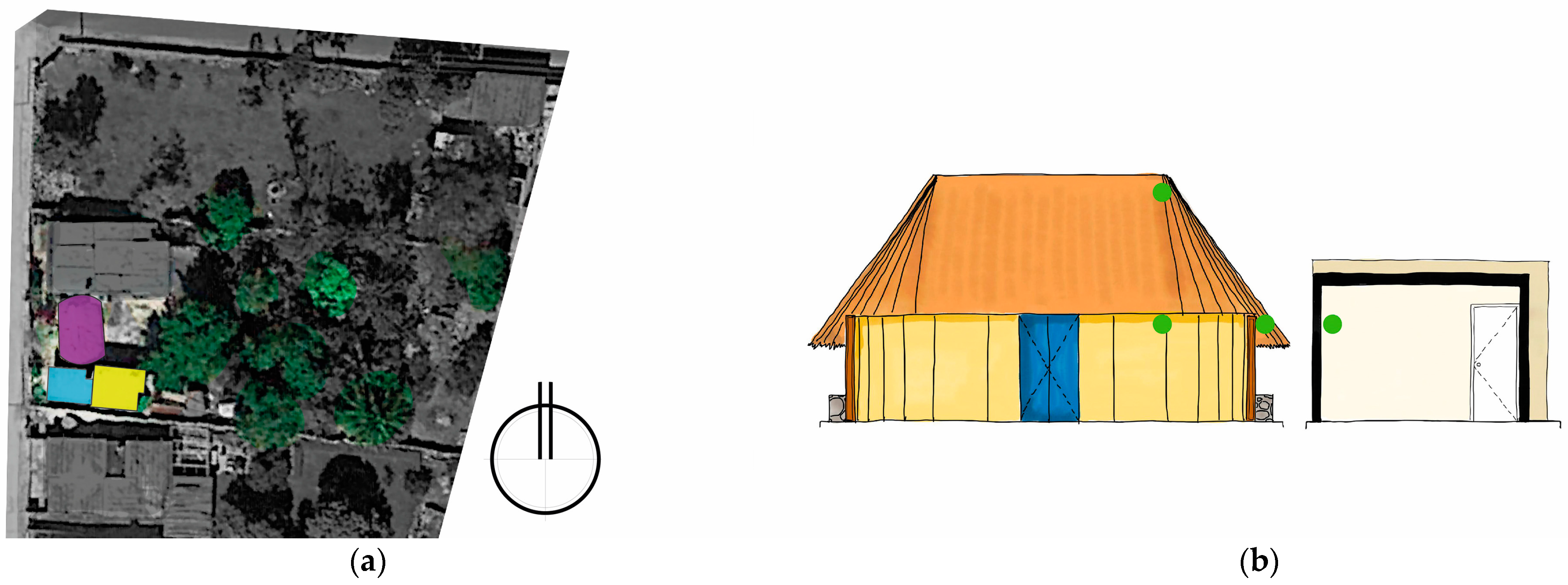

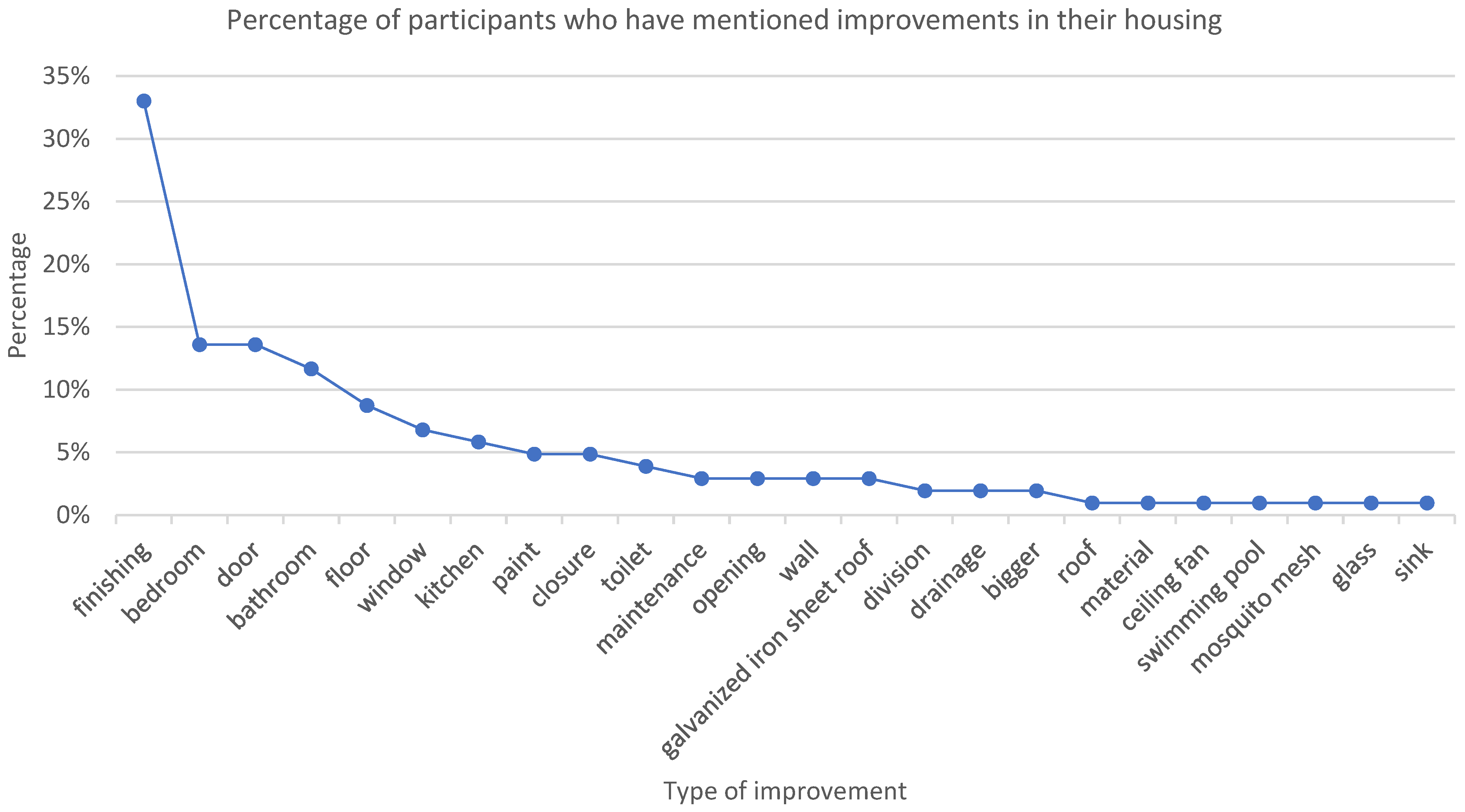
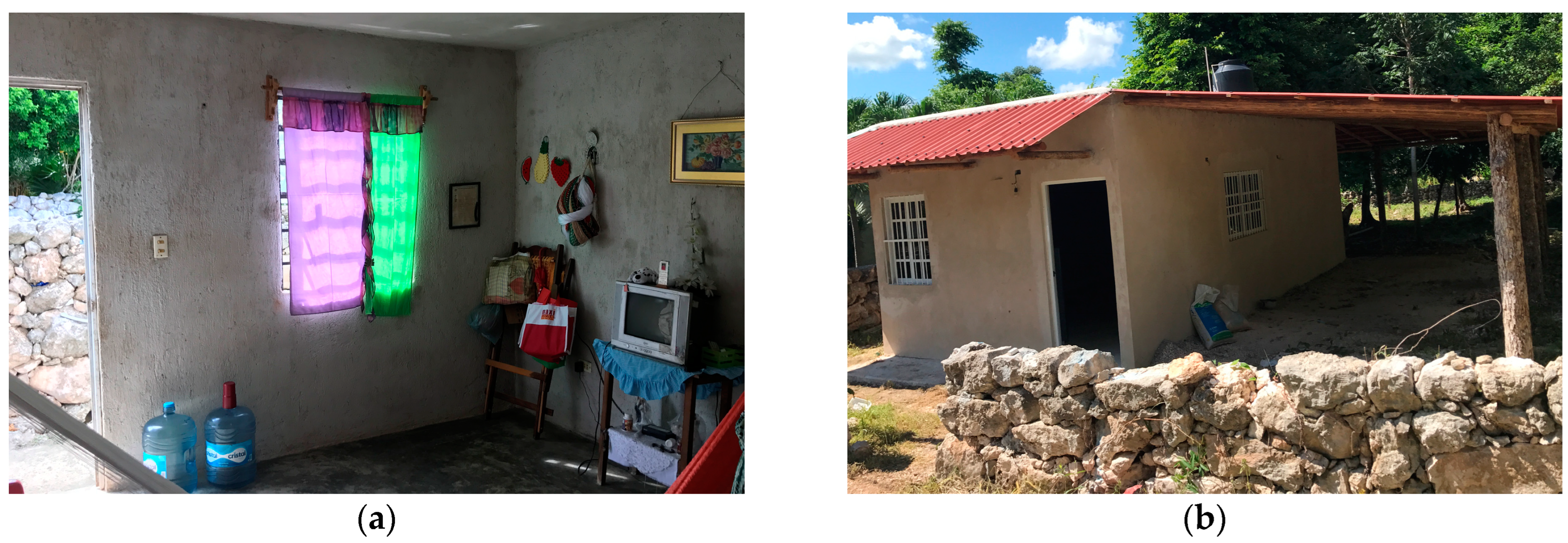
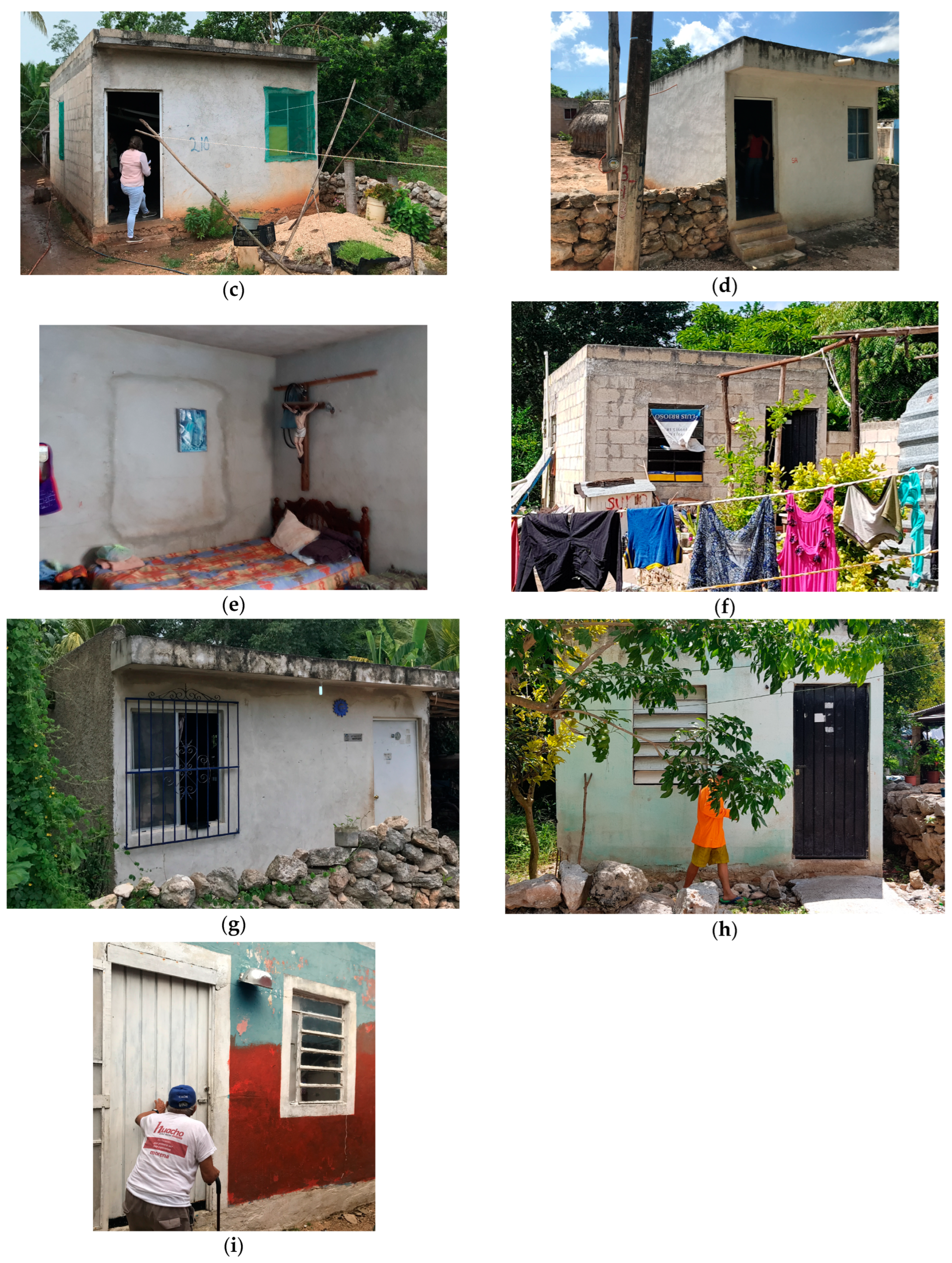



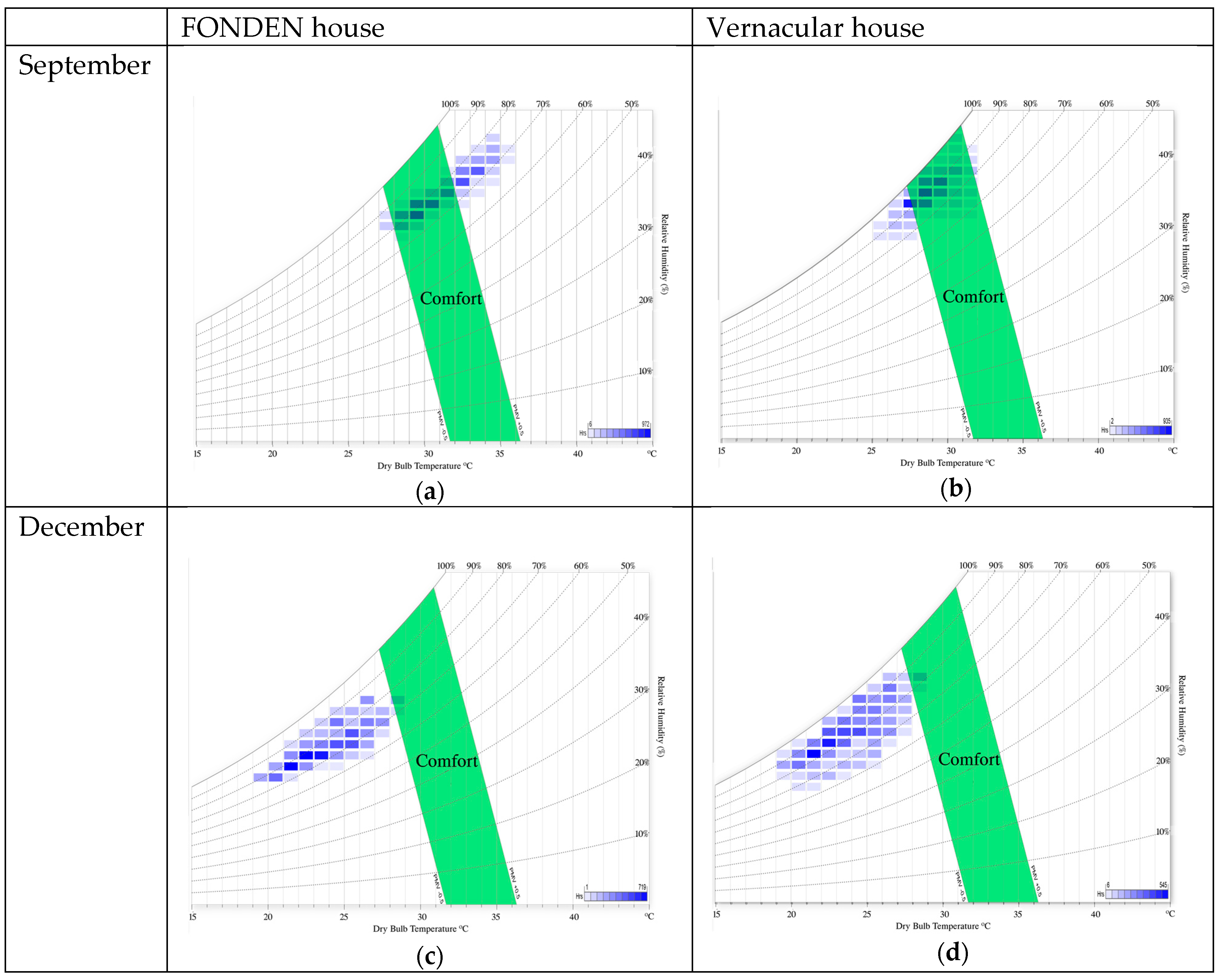
| September | 27.5 °C | 22.8 °C | 29.8 °C |
| December | 23.6 °C | 21.6 °C | 28.6 °C |
Disclaimer/Publisher’s Note: The statements, opinions and data contained in all publications are solely those of the individual author(s) and contributor(s) and not of MDPI and/or the editor(s). MDPI and/or the editor(s) disclaim responsibility for any injury to people or property resulting from any ideas, methods, instructions or products referred to in the content. |
© 2023 by the authors. Licensee MDPI, Basel, Switzerland. This article is an open access article distributed under the terms and conditions of the Creative Commons Attribution (CC BY) license (https://creativecommons.org/licenses/by/4.0/).
Share and Cite
Aguilar-Perez, Y.; Rodrigues, L.; Beccarelli, P.; Tubelo, R. Post-Occupancy Evaluation in Post-Disaster Social Housing in a Hot-Humid Climate Zone in Mexico. Sustainability 2023, 15, 13443. https://doi.org/10.3390/su151813443
Aguilar-Perez Y, Rodrigues L, Beccarelli P, Tubelo R. Post-Occupancy Evaluation in Post-Disaster Social Housing in a Hot-Humid Climate Zone in Mexico. Sustainability. 2023; 15(18):13443. https://doi.org/10.3390/su151813443
Chicago/Turabian StyleAguilar-Perez, Yarely, Lucelia Rodrigues, Paolo Beccarelli, and Renata Tubelo. 2023. "Post-Occupancy Evaluation in Post-Disaster Social Housing in a Hot-Humid Climate Zone in Mexico" Sustainability 15, no. 18: 13443. https://doi.org/10.3390/su151813443
APA StyleAguilar-Perez, Y., Rodrigues, L., Beccarelli, P., & Tubelo, R. (2023). Post-Occupancy Evaluation in Post-Disaster Social Housing in a Hot-Humid Climate Zone in Mexico. Sustainability, 15(18), 13443. https://doi.org/10.3390/su151813443










